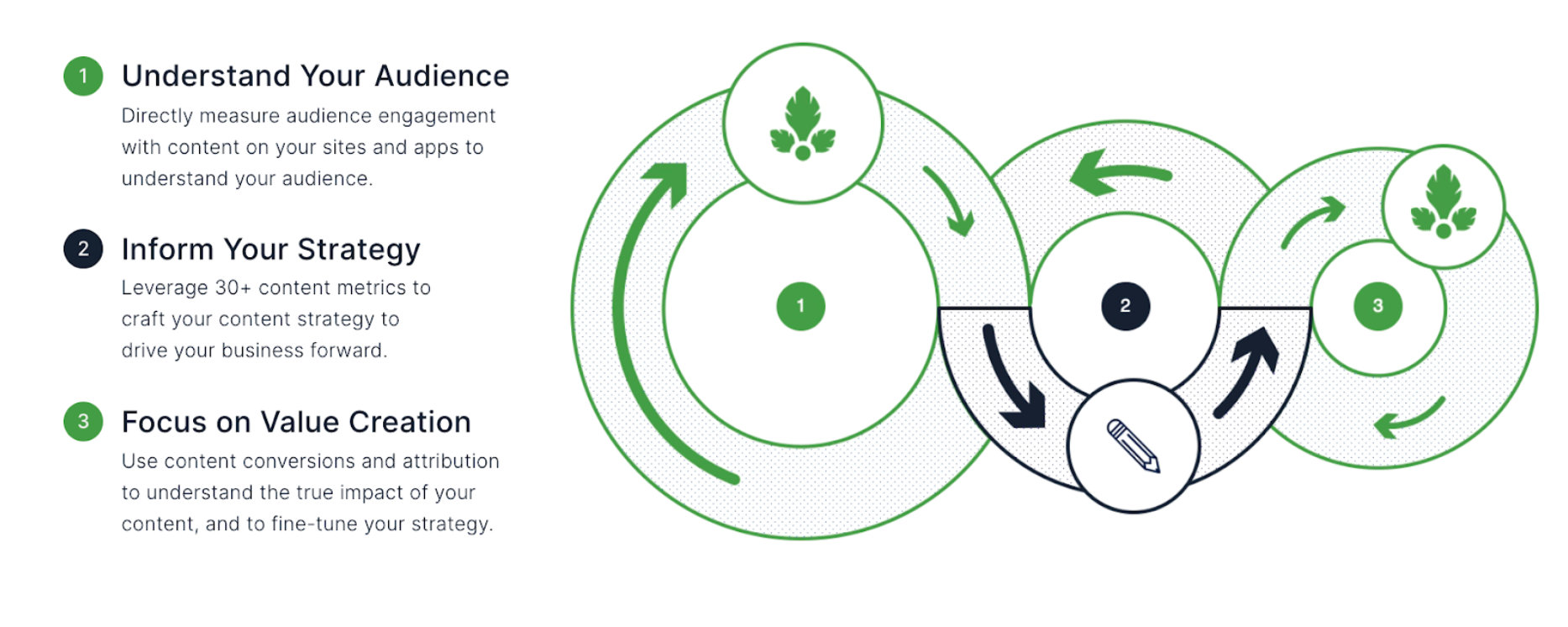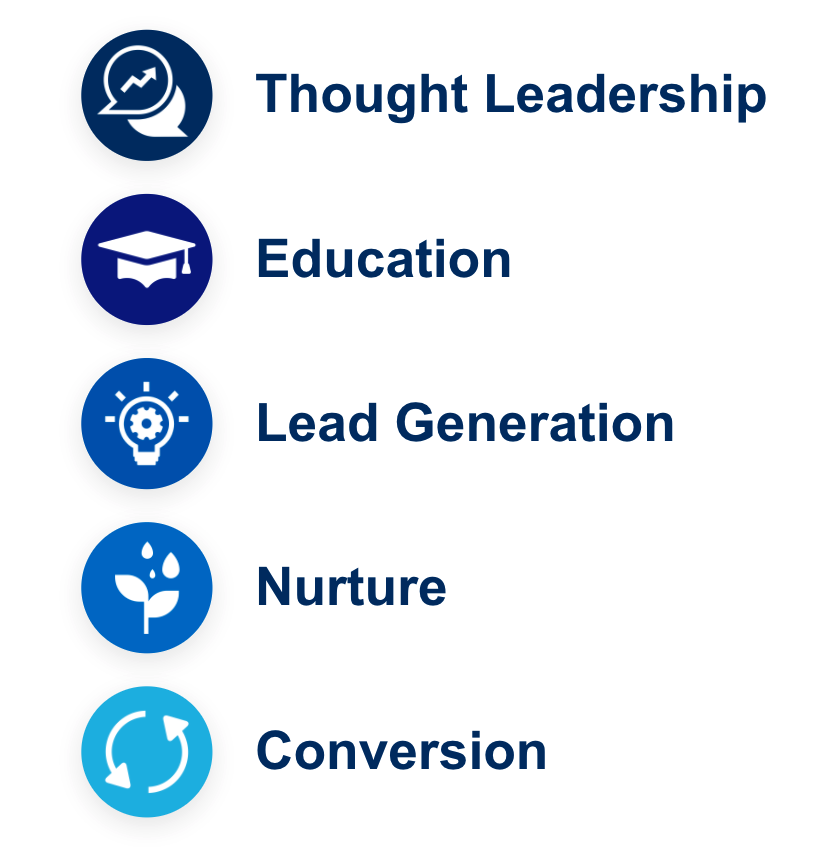4 Marketing Leaders Share their 2021 Content Strategy | Webinar Recap

Eighty-eight percent of your prospective customers are researching your company before they ever contact you, and they’re doing that through the content you put out online. What are you doing to make sure you’re getting the right message across to the right people?
With more digital content being produced than ever before, working with a smart, data-driven content strategy is crucial in attracting, engaging, and converting those valuable new customers. Whether you’re creating a blog post, an ebook, an article, a video, or any other form of content, you need to have the right data in place in order to know how it’s contributing to your business.
Earlier in January, Jen Jones – CMO at Dataminr, Russ Somers – VP Marketing at TrustRadius, Brendon O’Donovan – VP Product Marketing at Telesign, and Dave Cardiel – VP Marketing at Parse.ly joined up for a webinar to share their 2021 content strategies and how they set their teams up to hit their company goals. Whether you’re the seasoned leader of your content program or a novice content strategist looking for a place to start, this recap blog post will be a great resource for you and your team.
Table of Contents
- What is content strategy?
- Focus areas for 2021
- Telesign’s content strategy
- TrustRadius’s content strategy
- Dataminr’s content strategy
- Parse.ly’s content strategy
What is content strategy?
Content strategy is the process of creating and executing a plan to use content as a way to achieve the various goals you have as a business. It’s the tactics you use and the decisions you make around ideating, developing, packaging, and distributing content.
The term ‘content’ can mean different things to different people, so as we discuss content strategy and content marketing let’s make sure we’re on the same page. Between the four marketing leaders, they came up with a simple definition: content is value packaged and delivered to your audience of prospective buyers.
Focus areas for 2021?
To set the stage for our discussion, we asked the webinar audience what goals they’re focused on for content marketing in 2021. Consistent with our expectations, lead generation and engagement were top of mind. Lead gen is a common goal amongst content marketers because it relates directly to bottom-of-funnel revenue, and engagement tends to be a key KPI because it links closely to lead conversion. In the rest of the webinar, our panel went on to discuss how they use data to align their content strategies around these goals and run their content programs as lead gen + engagement engines.

Telesign’s content strategy – hiring and aligning for success
First up, Brendon walked us through his work at Telesign and how he thinks about building his team’s content strategy from the ground up. Telesign powers verification identity in communications for some of the world’s largest enterprises and targets a fairly tech-savvy audience, which Brendon explains leads the team to take a unique angle with content.
The marketing team is made up of two main groups: product marketing and growth marketing. Product marketing focuses on creating valuable content for prospects and customers, and growth marketing focuses on distributing and amplifying it. These teams are working in tandem towards a common goal for 2021: driving more inbound leads and relying less on the field team to create business opportunities.
In order to track their impact and progress towards this goal, Brendon’s team aligns on 4 main KPIs that represent the top, middle, and bottom of their marketing funnel: organic traffic, lead generation, pipeline generation, and influenced revenue. They track these KPIs through various metrics they measure with content analytics, optimizing for pageviews, users, and sessions for top-of-funnel content, downloads and lead captures for mid-funnel content, and pipeline or revenue for the bottom of the funnel.
Walking us through his process of building Telesign’s content strategy, Brendon stressed the importance of the hiring process before anything else, especially if you’re working with a smaller team like his. He said you want to make sure you’re bringing on people with ‘a head for content’, not just people who can write.
They need to be able to create a compelling piece of content, but just as importantly they need to understand how their work fits into the overall content strategy…what the ultimate goal of the content is, how the sales team will use it, what the rest of the team can produce, if they need extra outside resources to help, etc. Successful content marketers also rely on content analytics data to understand their target audience, create valuable content, and continue to improve and iterate.
Another point that Brendon stressed is the importance of aligning the rest of the company around his team’s content initiatives. Once his team starts executing their content strategy, iterating on it, and driving more inbound leads, the rest of the business team needs to know what to do to follow up. This means understanding what actions each lead takes on their site, where they come from, and what their intent is in taking those actions. Accessing this information through data and communicating regularly between teams builds trust in the power of their content program and ensures that the work of Brendon’s team doesn’t go to waste.
TrustRadius’s content strategy – connecting buyers and vendors through trusted content
Next, Russ spoke about leading the marketing team at TrustRadius and what their 2021 content strategy looks like. TrustRadius connects software buyers with trusted vendors by providing unbiased in-depth reviews. They create long-form research reports and host user-generated reviews for their audience of 1.2M B2B buyers.
TrustRadius has four teams all working together to execute their content program: research, SEO, product + brand marketing, and growth + demand generation. The research team deals with their ‘neutral’ content, so they’re responsible for generating user reviews and research. SEO works closely with the research team on the content roadmap, product + brand are focused on packaging the content and taking it to market, and growth + demand gen campaign to prospective customers with more traditional content marketing.
Russ’s team is targeting both companies who sell software as well as companies who are in the market for software, so they have different strategies for buyer content and vendor content. The goal of buyer content is providing value to a large audience of users, so the team optimizes for metrics like pageviews, engagement time, and referrals. On the other hand, the goal of vendor content is more to create demand, so the team optimizes for bottom-of-funnel KPIs like downloads, newsletter signups, and pipeline generated.
Since their buyer content is very SEO-focused, SEO analysis is always step one in the creation process. Then comes the content brief. Russ and his team rely on a standardized content-briefing process when creating buyer content in order to ensure alignment around goals. Here’s an example of one of the brief templates they fill out for every piece they make.

Russ stressed that committing to this process has been huge in streamlining their content creation workflows. It settles arguments quickly, he said. ‘What is the point? Let’s go back to the brief.’ They also stay organized by using an editorial calendar to keep track of themes, post dates, and stages of completion.
When it comes to TrustRadius’s vendor content, in the past Russ’s team focused heavily on long-form thought leadership pieces, but their plan to start out 2021 is to find ways to get more digestible, ‘seven seconds to value’ type content in front of their audience. That means repackaging deep, rich pieces into more digestible bits so that people who might not have time to read their denser reports can still access and get value from their insights.
Dataminr’s content strategy – serving multiple audiences with a large team
Jen stepped in to talk about Dataminr’s content program and her content strategy plans for 2021. Dataminr is a real-time data platform that detects the earliest signals of emerging risks and high-impact events from publicly available data and they serve three major markets: corporate enterprises, news organizations, and the public sector.
Jen’s team consists of a director of content marketing, a senior content manager, and a small army of content creators throughout the company. The dedicated two-person content team makes most of the strategy while the rest do most of the legwork. With so many people contributing content in one way or another, Jen stressed that alignment around goals and processes is key for her and her team. Like the group at TrustRadius, Jen’s team uses a content-brief for every piece to make sure they’re always creating with purpose.
They define a specific goal and target audience for each piece of content as well as which stage of the funnel it’s geared for. They think of a grid where each goal is matched with each target audience at each stage, fill the grid with each piece of content in their archive based on its goal/audience, and plan new content according to where they see gaps in the grid. Having a structured briefing process allows Jen and her team to quickly take stock of which audience goals they’ve already created content for and which they haven’t so they can prioritize their work and avoid duplicating efforts.
Parse.ly’s content strategy
Finally, Dave stepped up to speak briefly on Parse.ly’s content strategy and how we rely on content analytics to execute it. He explained that at Parse.ly, we think about content creation in three main steps: understand your audience, inform your strategy, and focus on value creation.

Just as Brendon, Russ, and Jen’s teams do, we incorporate data throughout our content strategy in order to inform, measure, and validate our work. We actually use our own product, Parse.ly Analytics which allows us to easily get data-driven insights on our content and audience. Without the visibility we get from content analytics, we’d be riding blind and wasting effort.
We look at our historical content data to understand what has been resonating with our audience and helping us achieve different goals in the past. Then we use that insight to decide what content to write and how to distribute it. Finally, we monitor the performance of the new content we deploy to make sure it’s providing value to the intended audience.
We also deploy our content under three types of campaigns: one to many, one to few, and one to one. One to many campaigns include higher-level long-form content that is meant to provide value to the vast majority of our target audiences. One to few campaigns are more targeted, providing specific audience cohorts with shorter-form content speaking to specific value points for their cohort. Lastly, one to one campaigns include strategic content pieces that are used to engage directly with target prospective accounts.

Did any of the strategies Brendon, Russ, Jen, and Dave discuss spark some inspiration for your own content strategy for 2021? Do you need any more help to decide how to set up your content program? This year is sure to bring its share of curveballs and challenges, so make sure you have access to the data that can support you along the way. Chat with one of Parse.ly’s product specialists today about how we can help you get started.

